7 Steps to Successful Product Planning [+Top Tools]
Last updated on Wed Mar 05 2025
Good product planning is what separates the products we use from the ones that fizzle into obscurity.
The best idea will never be more than an idea without a solid product plan in place. In fact, 95% of newly launched products fail.
So if you're thinking of building a product—or you have already started but don’t have a product plan in place—take the time to build one. This guide is here to help.
What’s in this guide:
What is product planning?
Why is the product planning process important?
How to plan your product step by step
Who should be involved in product planning
Top tools to support product planning
Introduction to product planning
At its core, product planning sets the foundation for every stage of a product’s lifecycle.
What is product planning?
Product planning is the structured process of defining a product’s direction, from ideation to execution. It involves identifying customer needs, market opportunities, and business objectives to ensure a product delivers real value. A well-planned product lifecycle includes research, roadmap development, prioritization, and iterative improvements based on feedback. Product planning helps teams make informed decisions, ensuring resources are used effectively and features align with user demands, just as restaurant inventory management software helps streamline operations by aligning stock levels with actual kitchen needs and customer demand.
It starts with market research and ideation, followed by validation, development, launch, and ongoing optimization. A strong product plan provides clarity on what to build, when to build it, and how to measure success. By setting clear priorities, companies can avoid wasted effort, reduce technical debt, and create products that solve real customer pain points.
What product planning isn't
Many confuse product planning with simple feature lists or one-time strategy meetings. It’s not a static document but an ongoing process that evolves with market trends and user feedback. Product planning is not project management—it focuses on what to build and why, whereas project management dictates how and when work gets done. Using engineering project management software can help teams coordinate tasks, track progress, and ensure timely delivery of complex projects. It also differs from general business strategy, which looks at overall company direction rather than specific product decisions.
Why is the product planning process important?
The product planning process is crucial because it provides a structured approach to developing and managing products. It supports the product management process by keeping your focus on the most important goals while minimizing scope creep.
Product planning strategy can also help you identify and navigate potential risks early in the development process—and jump on identified opportunities as well. This reduces the likelihood of product failure.
Lastly, product planning is not a one-time activity. It’s a continuous cycle of planning, feedback, and iteration. Through this cyclic process, product planning allows you to quickly adapt to changes in market conditions, customer preferences, and the competitive landscape. This allows you to maintain a strong market position over time.
How to plan your product step by step
The product planning process involves identifying customer needs, market opportunities, and strategic goals, and then translating these insights into a detailed plan. Here’s a step-by-step process to get your product plan underway.
Step 1. Concept development
The first step in product planning is to develop a clear and compelling concept. Also known as ideation, this step involves brainstorming ideas, identifying customer pain points that need to be resolved, and envisioning potential solutions.
The goal of concept development is to create a rough product concept. Keep the focus on the target audience and the potential to meet market demands. You’ll want to gain more insight into the market and competitors before diving into the details.
Also, make sure you are gathering input from various stakeholders, including customers, at this stage. This will ensure your concept is grounded in real needs.
Step 2. Market analysis
The next step is to conduct a thorough market analysis. This is where you will validate the demand for your concept and identify potential customer segments. Market analysis involves:
Researching customer demographics and behavior
Analyzing market trends and growth potential
Identifying and segmenting the target audience
Evaluating economic factors that may influence demand
Assessing potential barriers to market entry
Determining the size and scope of the market opportunity
Through the market analysis, you’ll gain the insight needed to refine your product concept and ensure it is aligned with market needs and opportunities.
Step 3. Competitive research
With your product concept refined through your thorough market analysis, it is time to understand the competition. Competitive research is how you’ll understand. It will define the arena in which your product will compete.
For each potential competitor:
Analyze all their products
Identify their strengths and weaknesses
Understand their positioning in the market
Review their roadmap and recognize their trajectory
By understanding what competitors offer, you can identify gaps in the market and opportunities to differentiate your product. And, understanding their trajectory will make sure they are not two steps ahead of you with the same concept.
Step 4. MVP development
With market and competitive insights in hand, the next step is to develop your Minimum Viable Product (MVP). The MVP is the simplest version of your product. It includes only the essential features necessary to solve the core customer problem.
The goal of the MVP is to prove the practicality of your concept by beta testing the product with real users. This is where you’ll gather feedback and make data-driven improvements before committing to full-scale development.
A successful MVP will also captivate your target market and win them over to your brand even while you are still creating a fully functional SaaS application.
Step 5. Product launch
Once the MVP has been validated and refined, it’s time to prepare for the product launch. This step involves:
Developing a go-to-market plan
Creating product marketing strategy
Establish the sales plan
Aligning all teams on the launch objectives
The launch phase is critical for generating initial traction and setting the stage for the product’s success. It’s important to have clear metrics in place to measure the success of the launch and adjust strategies as needed.
Step 6. Lifecycle management
After the product is launched, the focus shifts to lifecycle management. Lifecycle management ensures that the product remains competitive, meets evolving customer needs, and continues to deliver value.
Lifecycle management involves:
Continued monitoring of the product’s performance in the market
Obtaining customer feedback
Making continuous improvements
Managing updates
Enacting enhancements
Implementing potential expansions
Step 7. Product sunsetting
At some point a product may reach the end of its product lifecycle. This can be the result of declining demand, market saturation, or the introduction of new technologies. Regardless of the reason, if the time comes to wind down your product don’t just pull the plug.
Product sunsetting is the process of phasing out a product in a way that minimizes disruption for customers and the company. This achieve this make sure you:
Plan the discontinuation
Communicating with stakeholders
Ensuring that support and transition plans are in place for existing users
At a higher level, effective product portfolio management helps companies balance new launches, active products, and retiring ones to drive long-term success.
The product roadmap: communicating your plan
A product roadmap is more than a list of upcoming features—it’s a strategic communication tool that aligns teams, sets expectations, and ensures long-term focus. A well-crafted roadmap keeps stakeholders informed, helps teams make better decisions, and provides customers with clarity on what’s ahead.
Here's an example roadmap:
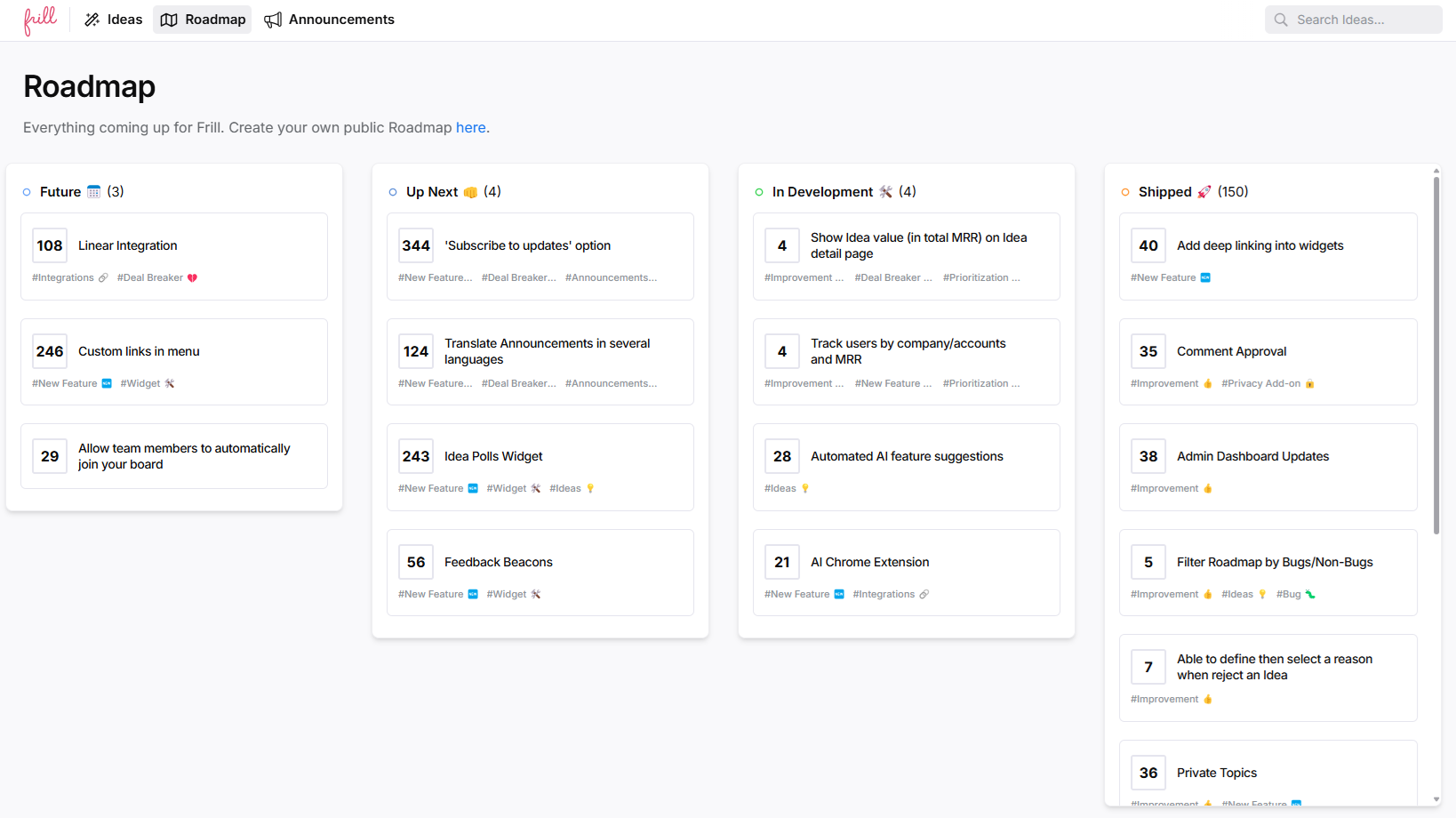
Types of product roadmaps
Roadmaps vary based on business goals and audience. Feature-based roadmaps focus on delivering specific functionalities. Outcome-driven roadmaps prioritize measurable impacts like engagement or retention. Goal-oriented roadmaps align development with company-wide objectives, ensuring every initiative contributes to broader success.
How to prioritize features & updates
Prioritization must balance customer demand, business impact, and technical feasibility. Data-driven decision-making ensures resources go toward high-value initiatives. Use methods like the RICE framework, MoSCoW prioritization, or user voting systems to validate what truly matters.
Best practices for sharing the roadmap
Internal roadmaps should drive alignment between product, engineering, sales, and marketing. For customers, a public roadmap increases transparency, builds trust, and fosters engagement. However, avoid over-promising—communicate priorities without rigid timelines to maintain flexibility.
Common mistakes in product planning (and how to avoid them)
Avoid these major mistakes.
Treating planning as a one-time event – Product planning isn’t a one-and-done exercise. Markets shift, customer needs evolve, and competitors adapt. A static plan quickly becomes obsolete. The best teams treat planning as a continuous process, regularly revisiting strategy, updating roadmaps, and adjusting priorities based on new data. Try using a dual-track agile approach to manage continuous discovery.
Overplanning for the future & losing flexibility – Long-term vision is important, but excessive planning locks teams into rigid roadmaps that don’t account for change. Overcommitting resources to unvalidated features slows innovation. Instead, maintain a flexible, outcome-driven plan that allows for quick pivots based on market feedback.
Siloed planning without cross-team collaboration – A roadmap built in isolation leads to misalignment between product, engineering, marketing, and sales. If teams aren’t involved in planning, execution suffers. Ensure ongoing collaboration, hold regular alignment meetings, and create a shared product vision that keeps everyone moving in sync.
Making assumptions without user validation – Building based on gut instinct instead of user data is a costly mistake. Validate ideas early through surveys, interviews, and analytics. Real customer insights should drive decisions, not internal opinions.
Focusing on outputs instead of outcomes – Shipping more features doesn’t guarantee success. A strong product plan prioritizes impact over output, ensuring that every release moves the needle on adoption, retention, and business goals.
Who should be involved in product planning?
Product planning is a team effort. When developing or maintaining a plan be sure to include:
Product Managers: They will lead the product planning process, define the product vision, and ensure alignment with business goals.
Designers: Contribute to the concept development and user experience design. Ensure the product meets customer needs aesthetically and functionally.
Engineers/Developers: Provide technical input on feasibility and contribute to the development of the MVP and final product.
Marketing Team: Develop the go-to-market strategy and ensure the product is effectively positioned and promoted in the market.
Sales Team: Offer insights into customer needs and competitive pressures. They help shape product features and sales strategies.
Customer Support: Provide feedback on customer pain points and needs. They help with product improvements and lifecycle management.
Executives: Ensure that the product planning aligns with overall company strategy and allocate resources accordingly.
Top tools to support successful product planning
There are many product planning tools available to help you organize your ideas, gain customer feedback, establish priorities, and plan your trajectory. Here are the top four tools we have found to really help out in the product planning process.
1. Idea boards
Idea boards are essential for capturing, organizing, and prioritizing product ideas. They allow teams to visualize and collaborate on potential features, improvements, or new product concepts.
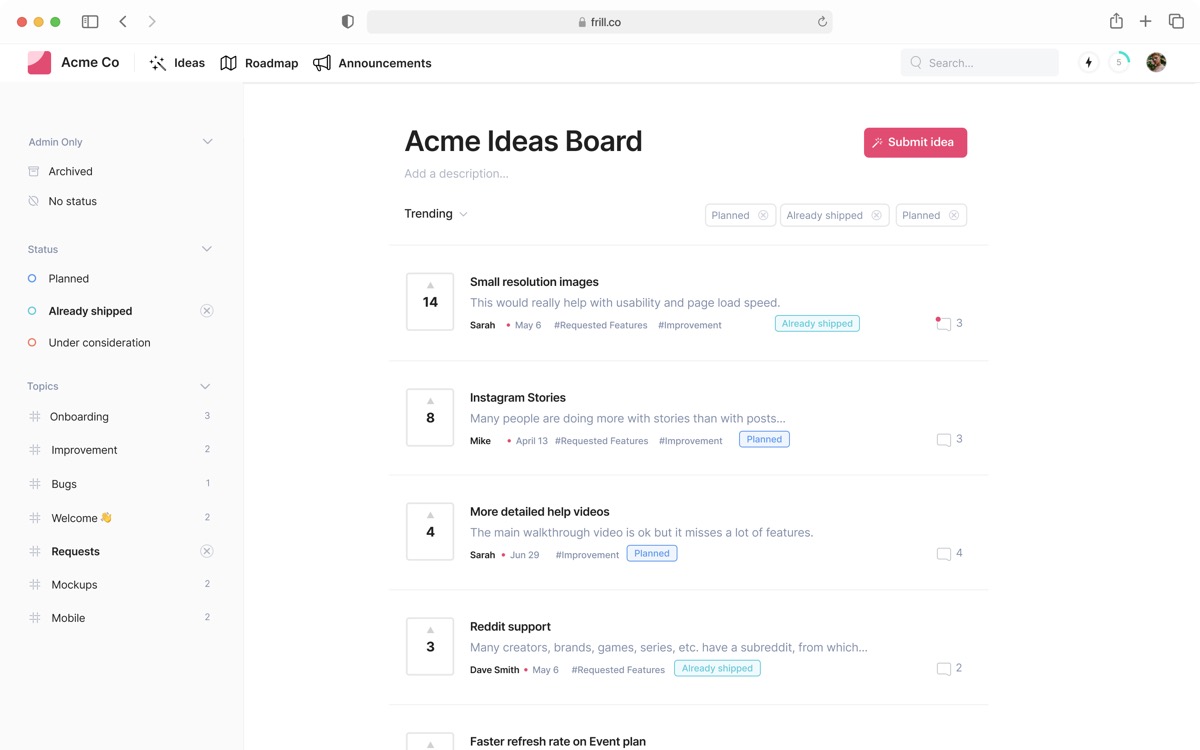
At Frill, we offer a robust idea management tool that enables teams to gather ideas from internal stakeholders and customers, prioritize them based on impact, and track them through the development process.
2. Whiteboards
Whiteboards are crucial for brainstorming sessions, mapping out product concepts, and visualizing workflows. They provide a flexible space for teams to collaborate, sketch out ideas, and iteratively refine them.
There are many whiteboard apps to choose from. Each option has their pros and cons, so consider what features are important to you before evaluating your potions.
Miro is a popular option for digital whiteboards. Here’s an example of a whiteboard built with Miro:
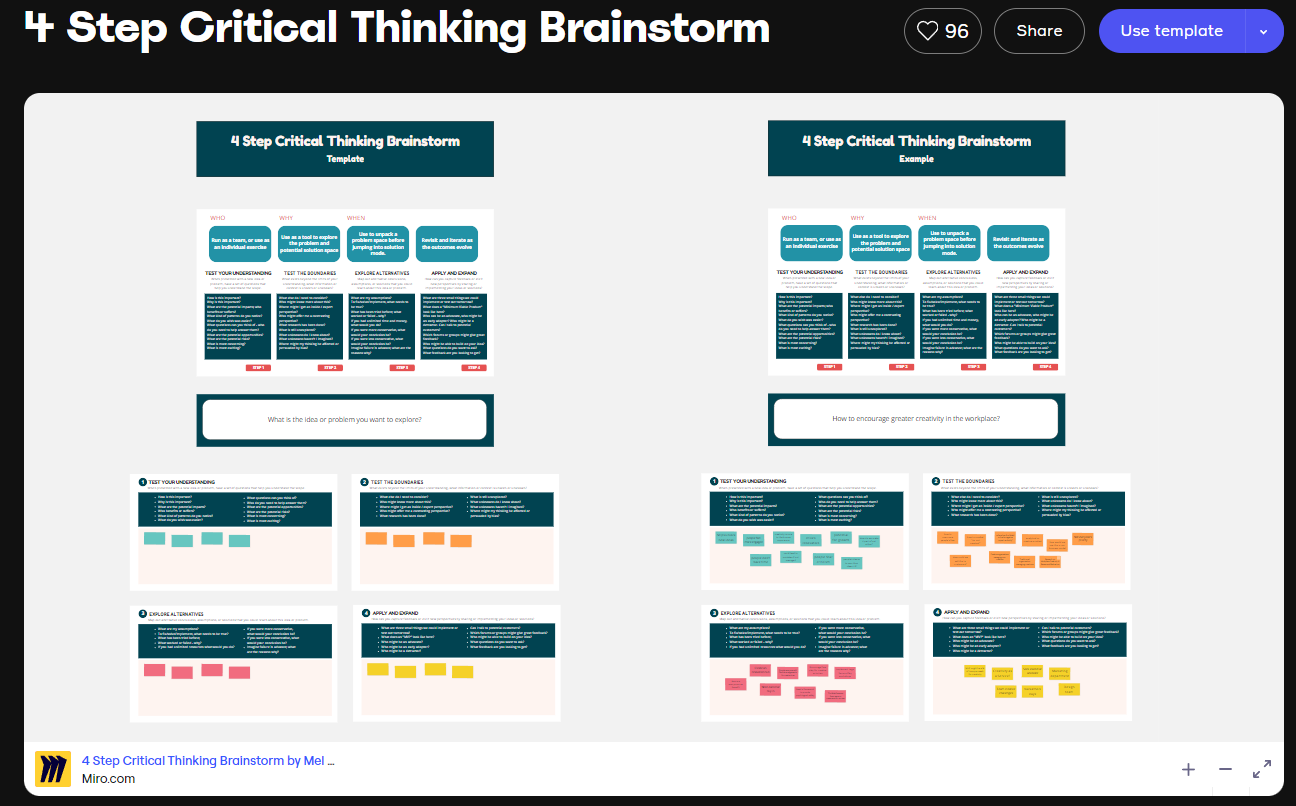
3. Roadmaps
Product roadmaps are strategic documents that outline the vision, direction, and progress of a product over time. They help align the team around shared goals, communicate the product strategy to stakeholders, and make the users feel heard and appreciated.

There are many product roadmap templates available. We offer an intuitive one that enables product teams to plan, share, and update their product roadmaps. This ensures transparency and alignment across the organization.
4. Prioritization matrix
A feature prioritization matrix is a tool used to evaluate and prioritize product features or tasks based on factors like impact, effort, and urgency. This tool helps product teams make informed decisions about where to focus their resources to maximize value.
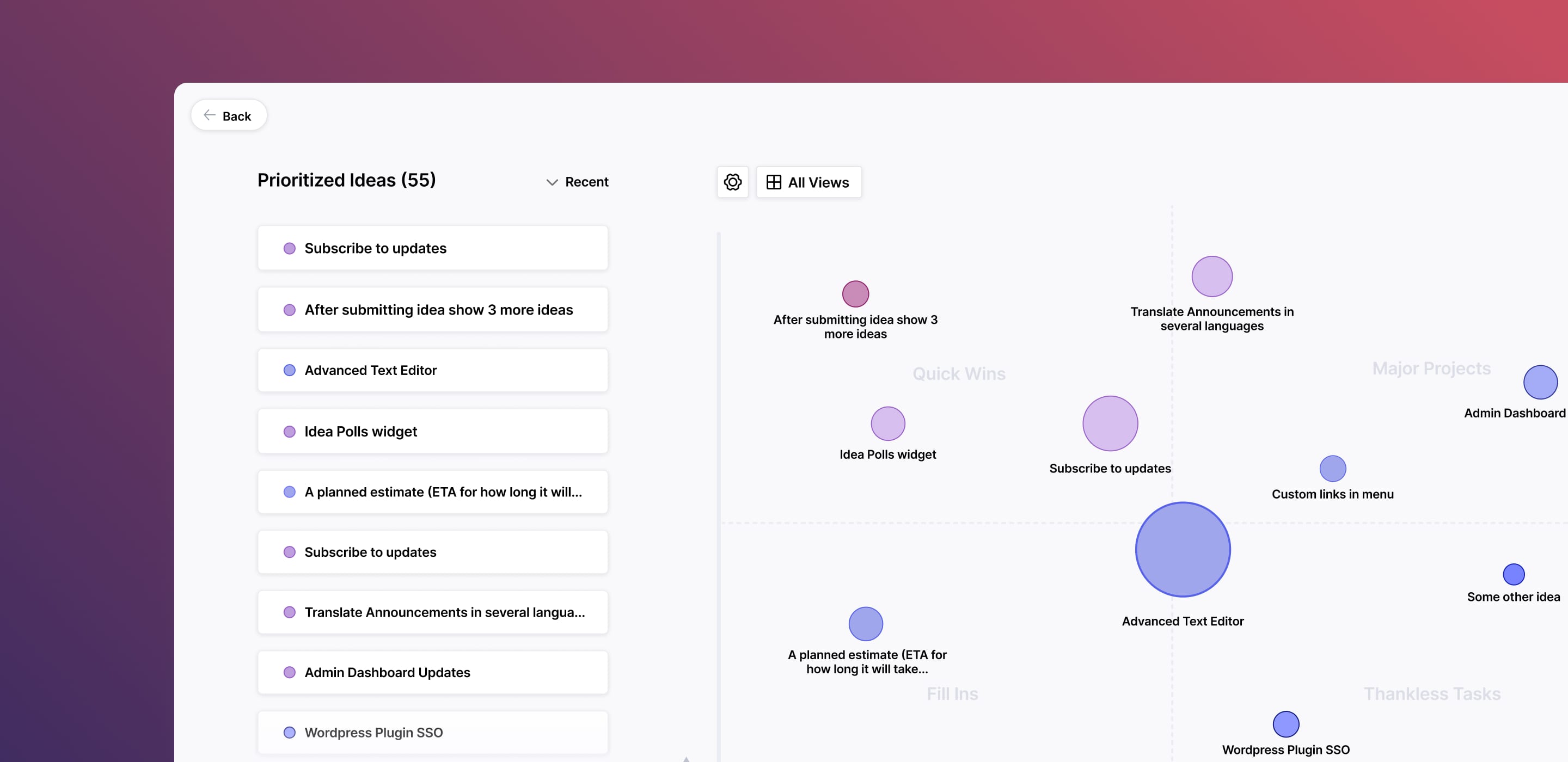
Frill makes prioritizing your feature requests simple. After setting priority values for the different feature requests, the matrix automatically groups requests by key words/phrases and incorporates feature voting as well. This makes assessing and ranking feature requests easy.
Best platforms for product planning and management
Here are the top tools for product planning. We present options that are simpler and better suited for small businesses and startups, as well as platforms that are ideal for enterprise teams.
1. Frill
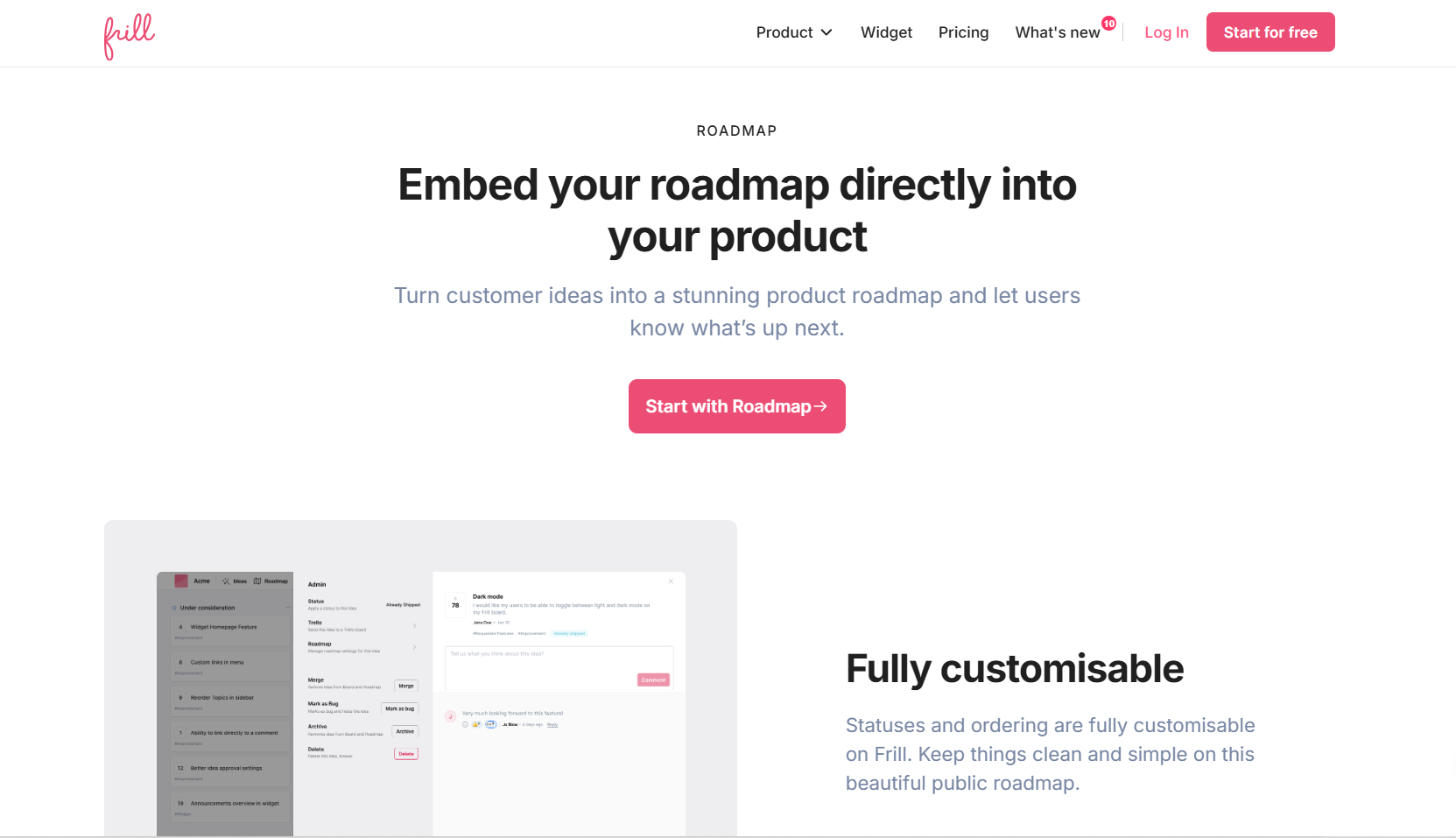
Frill is a simple yet powerful feedback tool designed for SaaS companies to collect, manage, and act on user feedback. It goes beyond gathering insights by offering public roadmaps and announcements, keeping customers informed on feature development and updates. Users can also upvote ideas, helping teams prioritize what matters most.
Key Features:
Feedback boards for collecting and organizing user ideas
Public roadmaps to showcase upcoming features
Announcements to keep users informed about updates
Customizable widgets for seamless feedback collection
Integrations with Slack, Jira, Trello & more
Automated status updates to engage users
Single sign-on (SSO) for secure authentication
Multi-language support and unlimited widgets
Prioritization tools to focus on high-impact ideas
Pricing: Frill offers flexible pricing for teams of all sizes. The Startup plan starts at $25/month, while larger companies can unlock unlimited ideas and white-labeling for $49 or $149/month.
2. Hellonext
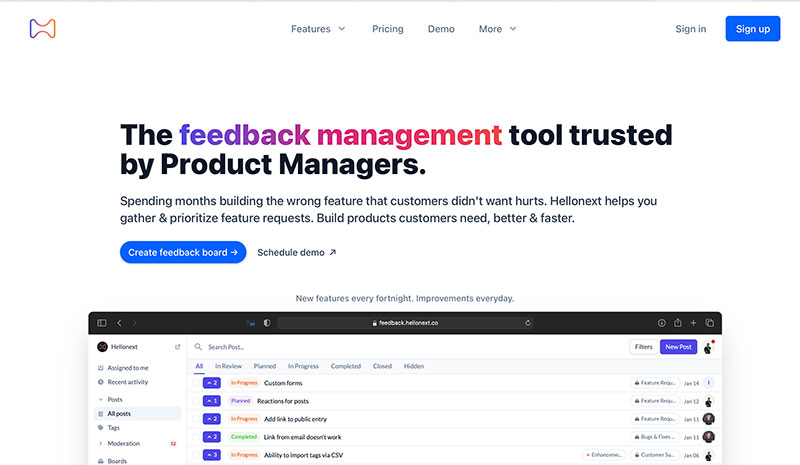
Hellonext is a powerful yet easy-to-use feedback tool designed to collect, manage, and prioritize user input. With public and private feedback boards, users can upvote, downvote, and track feature requests, making it easy to identify what your product needs. It also doubles as a bug reporting tool for quick issue resolution.
Key Features:
Feedback boards for collecting user input
Public roadmaps and changelogs for transparency
Feature voting to prioritize requests
AI-powered feedback analysis
Jira, Slack, and Zapier integrations
Automated notifications and real-time analytics
Custom branding and white-label options
Pricing: Hellonext’s base plan starts at $12/month, offering unlimited feedback and tracked users. Higher-tier plans ($25–$50/month) unlock additional feedback boards and advanced features.
3. Pendo
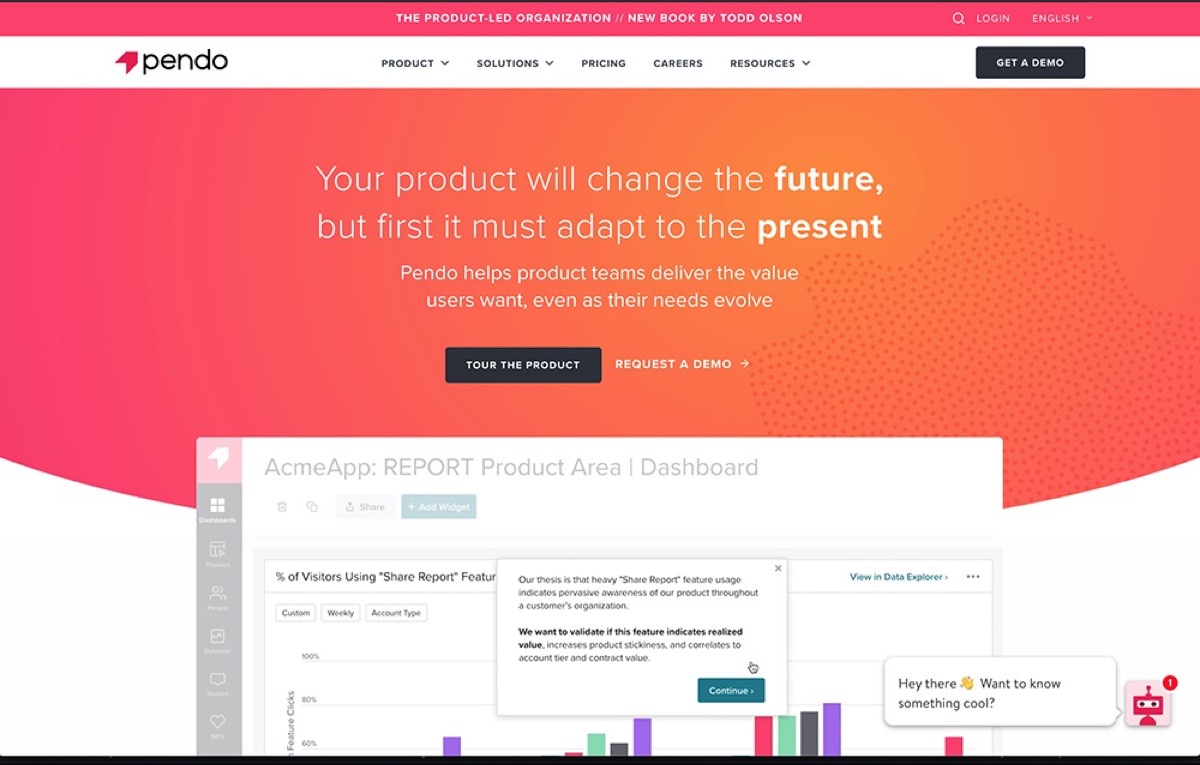
Pendo helps SaaS companies and mobile apps analyze user behavior, improve adoption, and collect feedback. It offers in-depth analytics, AI-driven insights, session replays, and NPS tracking to enhance the user experience.
Key Features:
In-app messaging for onboarding and feature adoption
Advanced product analytics and user behavior tracking
NPS surveys and customer feedback tools
Product roadmap visualization and management
Automated guides and walkthroughs for training
Retention and churn analysis
Pricing: Pendo’s pricing isn’t listed publicly—contact sales for details. A 30-day free trial lets you explore its features before committing.
4. ProductBoard
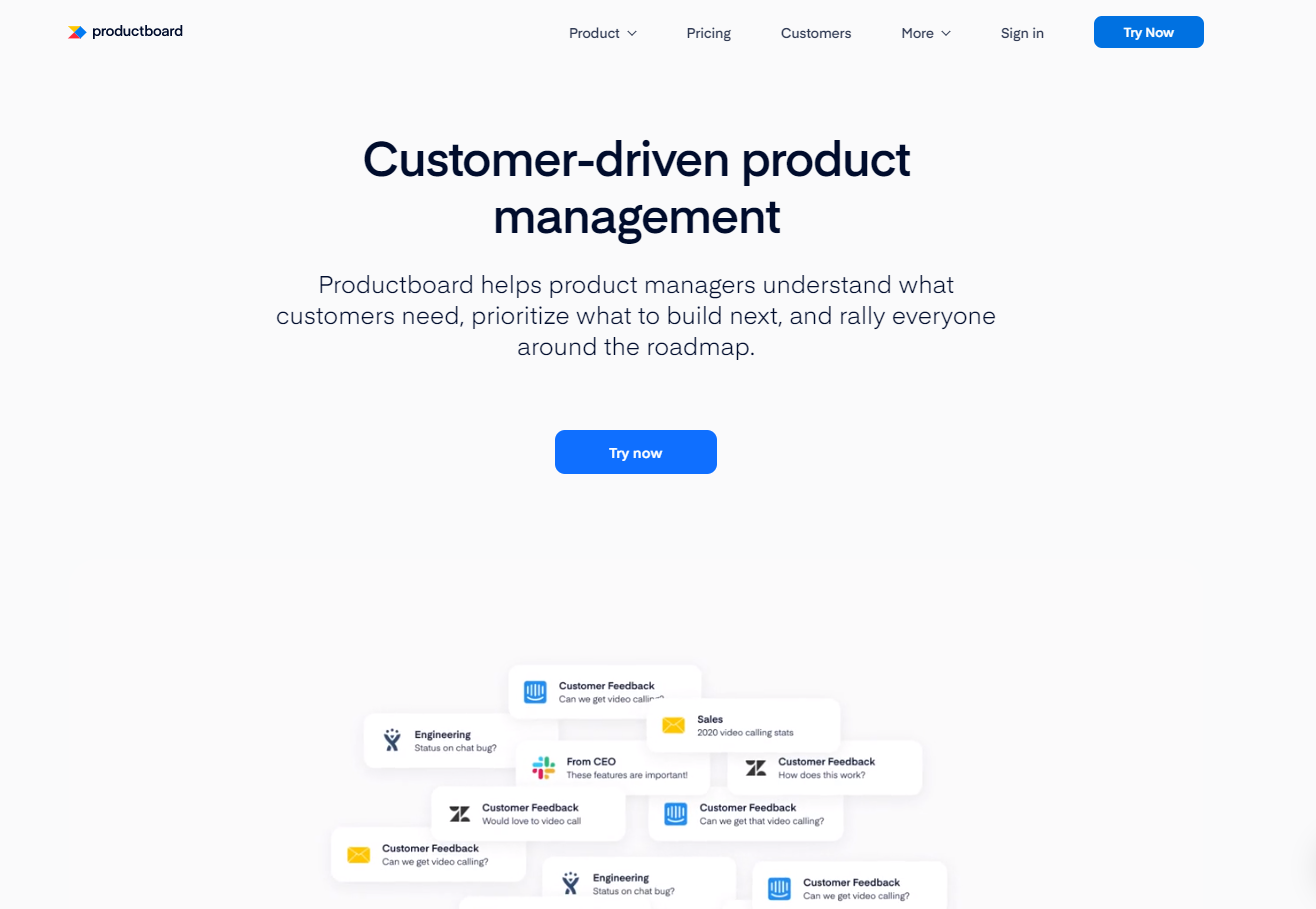
Productboard collects, organizes, and prioritizes user feedback in one place, ensuring you never miss a request or idea. Easily categorize feedback and share it with your team to drive action.
Key Features:
Visual feedback collection with screenshots and recordings
Jira, Slack, Trello, and Zendesk integrations
Customizable feedback widgets and dashboards
Real-time bug reporting with user metadata
Automated workflows for feedback management
Pricing: Plans start at $20/month for small teams, with $50 and $100/month options for larger companies.
5. ProductPlan
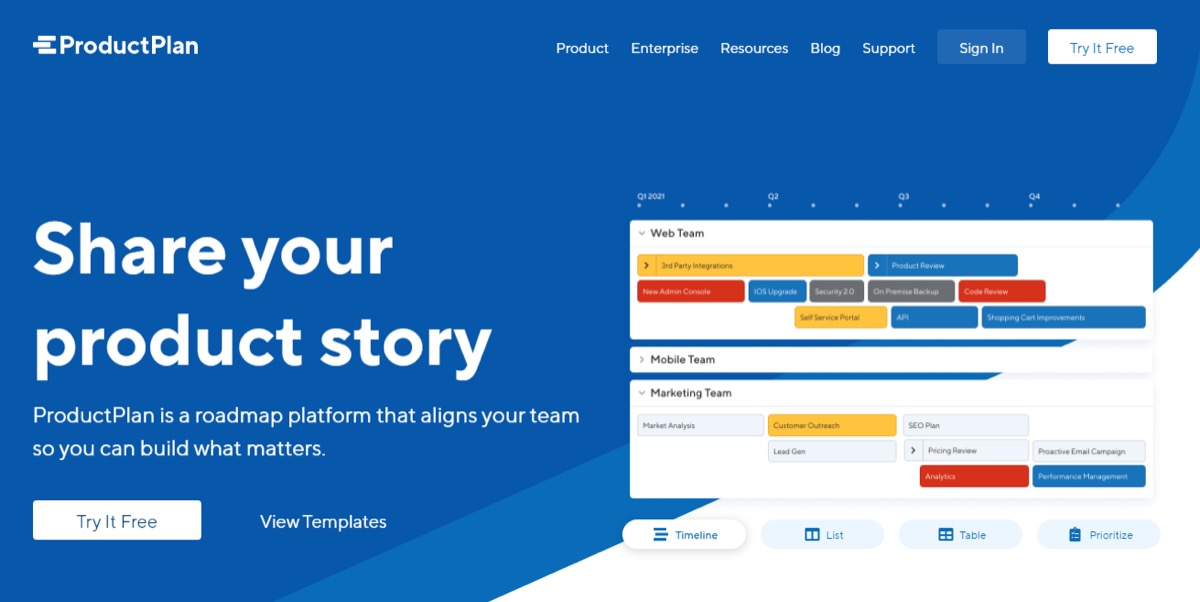
ProductPlan helps teams plan, prioritize, and launch products with confidence. Trusted by leading companies, it offers intuitive roadmapping, goal alignment, and seamless collaboration tools to streamline product development.
Key Features:
Unlimited roadmaps with customizable views
Prioritization board to focus on high-impact work
Portfolio views for tracking multiple initiatives
AI-generated roadmap summaries for quick insights
Opportunity validation to assess product ideas
Launch management to streamline releases
Strategic portfolio alignment with business goals
Robust integrations with Jira, Slack, Trello & more
Pricing: ProductPlan offers custom pricing based on team needs. Contact sales for details or book a demo to explore its features.
Collecting high-quality feedback requires a multi-channel approach. Surveys, in-app tools, NPS scores, and direct customer interviews provide critical insights, but an always-on solution like Frill’s idea board gives users a place to leave feedback anytime, upvote ideas, and engage in meaningful discussions. Organizing, analyzing, and prioritizing this feedback ensures data-driven product improvements.
Ready to start your product planning? With Frill you can gain many of the tools to support the continued success of your product planning. Get started today.